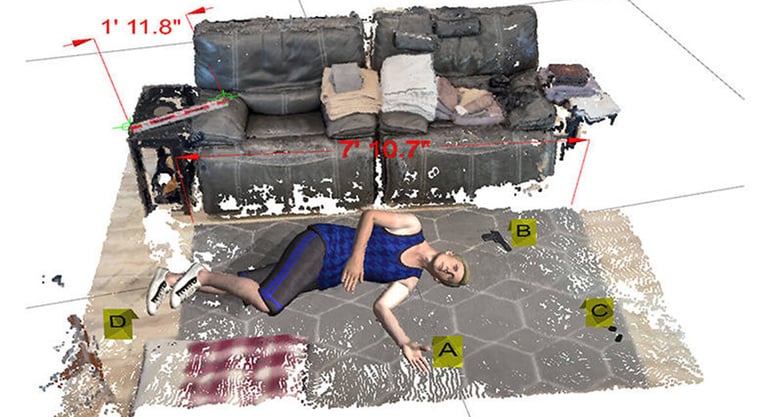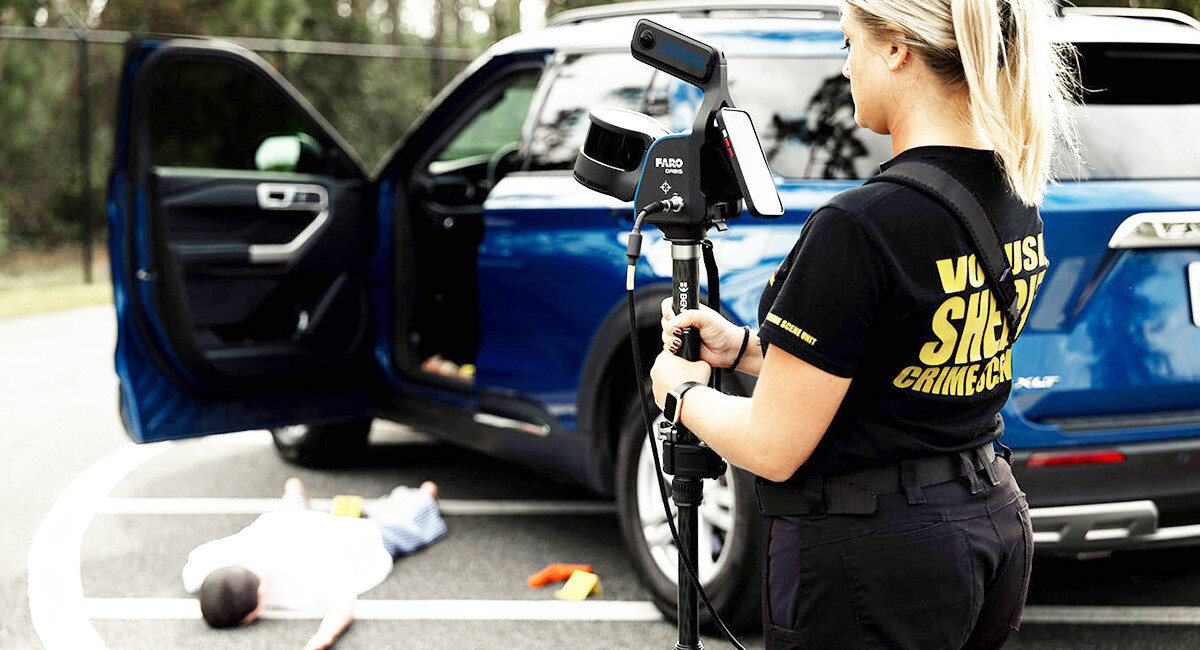Forensic Laser Scanning: Advancing Crime Scene and Crash Investigation
Laser scanning is rapidly gaining acceptance and becoming more commonplace in the law enforcement and crash reconstruction communities. Over the past few years, forensic tools, hardware, and software have improved significantly, creating a simpler, more effective system to capture immense 3D detail in a short period of time.
Original Source - FARO Technologies

Forensic Laser Scanning: Advancing Crime Scene and Crash Investigation
Laser scanning is rapidly gaining acceptance and becoming more commonplace in the law enforcement and crash reconstruction communities. Over the past few years, forensic tools, hardware, and software have improved significantly, creating a simpler, more effective system to capture immense 3D detail in a short period of time.
What Is Forensic Laser Scanning?
Forensic laser scanning is the use of 3D laser scanning technology to digitally capture and reconstruct crime scenes, accident sites, and forensic evidence with high accuracy. This technology allows investigators to create accurate, measurable, and detailed 3D models of a scene for forensic analysis, forensic failure analysis, and forensic reconstruction.
How It Works
Using a crime scene 3D laser scanner, investigators can capture millions of data points in a matter of minutes, documenting evidence in its exact location. These high-resolution 3D scans allow for comprehensive forensic analysis without disturbing the scene, improving both accuracy and efficiency in crash investigation and crime scene documentation.
Key Benefits for Investigators
Comprehensive Scene Preservation — Laser scanning digitally archives crime and accident scenes, allowing investigators to revisit them virtually.
Improved Accuracy — High-resolution forensic reconstruction reduces human error in measurements.
Enhanced Crime Scene Technology — Scans integrate seamlessly with courtroom technology for compelling trial presentations.
Top 10 Reasons to Use Laser Scanning for Forensics
- Easy to use: Many manufacturers are moving toward a simpler interface making operation of the scanner more like a digital camera than a complicated survey instrument. The laser scanning workflows that are now being developed are more intuitive, automated, and easy to use with minimal training than ever before.
- Portability: Laser scanners are smaller in size today than ever before, making them easier to deploy to a crime/crash scene and useable by just about anyone.
- Safety: Data can be collected from a distance, with some scanners, like the FARO® Focus Premium Max, collecting measurements up to 400 meters away. This allows the operator to scan a scene out of harm’s way. In addition, laser scanners can collect up to 1,000,000 points per second with average scan times of several minutes. Less time on a scene means less time for potential danger to the individuals at the scene. Class I lasers are also being used in laser scanners, creating a truly eye-safe environment during the scan.
- Speed and efficiency: Complete color scans can be captured in as little as several minutes creating a virtual scene with high accuracy and detail that can be revisited over and over without physically traveling to the site. In contrast to traditional methods of surveying/documenting a scene, laser scanning is much faster and allows multiple investigators to have eyes on the virtual scene.
- Produce a variety of deliverables: Once the scene has been laser scanned, various types of final products can be extracted or produced from the data. For example, anything from a traditional 2D drawing to a detailed 3D animation can be created from the scan data.
- Peer pressure: With more and more agencies using laser scanners for their scene documentation, the result is more widely accepted. As well as growth in expectations that future scenes will be documented in 3D.
- Cost effective: Laser scanners are becoming more and comparable in price to total stations, which are traditionally used for documenting traffic accidents.
- Specialized measurement tools: Software for forensic analysis from 3D data also now includes special tools for measuring blood spatter and bullet trajectory, witness/suspect height, etc.
- Easy to share: More software tools are available to view and document the scan data without the requirement of installing software or purchasing additional licenses.
- Archive the scene: Once the scene has been laser scanned it has been essentially frozen in time, preserved for future virtual visits by anyone who may wish to investigate the scene. This allows for measurements to be taken that may not have necessarily been thought to be important at the time of capture as well.
Forensic Tools That Work Best with Laser Scanning
Forensic laser scanning integrates with various forensic tools to enhance investigations, including:
- Accident reconstruction software for analysing crash dynamics.
- Blood spatter and bullet trajectory analysis tools for crime scene investigations.
- Virtual reality and courtroom technology to present forensic evidence effectively in trials.
How to Choose the Right Crime Scene Scanner

Selecting the best crime scene scanner depends on:
- Range and Accuracy: Higher accuracy scanners are ideal for forensic failure analysis and detailed crime scene documentation.
- Portability: A lightweight, mobile scanner is beneficial for accident investigation teams in the field.
- Integration: Compatibility with forensic reconstruction and courtroom technology ensures seamless case analysis.
The Future of Crime Scene Technology
Crime scene technology continues to evolve, with advancements such as:
- AI-powered forensic analysis to automate evidence detection.
- Augmented reality (AR) visualisation for real-time forensic reconstruction.
- Cloud-based forensic tools to improve data sharing and collaboration.
FAQs
What Is Laser Scanning in Forensics?
Laser scanning in forensics is the process of using 3D laser scanners to capture, measure, and document crime scenes, accidents, and forensic evidence digitally.
How Does Laser Scanning Help in Crime Scene Investigation?
It allows investigators to accurately record and analyse scenes, reducing the chance of human error and preserving evidence in a virtual environment.
How Does Laser Scanning Compare to Traditional Forensic Methods?
It is faster, more accurate, and provides a comprehensive 3D record, unlike traditional sketching and photography.
Is Laser Scanning Used in Courtroom Presentations?
Yes, 3D forensic reconstructions are increasingly used in trials to visually demonstrate evidence to juries.
What Equipment Is Needed for Forensic Laser Scanning?
A high-accuracy laser scanner, forensic software for analysis, and courtroom technology for presentation are essential tools.



